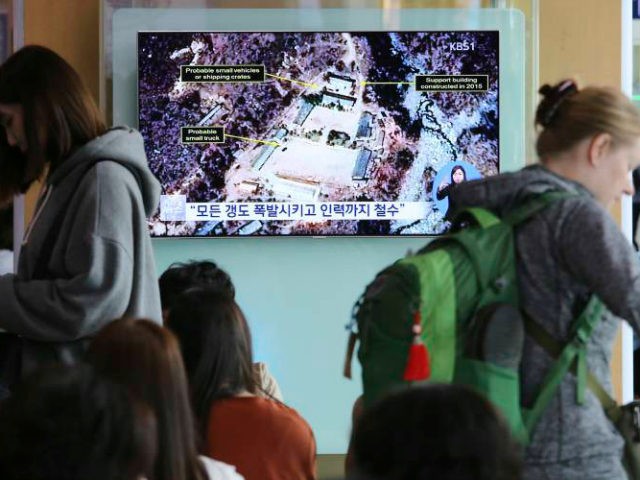North Korea reportedly charged international reporters $10,000 each for flight visas to cover the shutdown of the Punggye-ri Nuclear Test Site, scheduled to occur sometime between May 23 and 25, weather permitting.
An average visa typically ranges in price from $40 to $160 depending on country of origin, according to South Korea’s JoongAng Ilbo. The newspaper estimates that the total cost per reporter of covering the event for the media outlets that participate could be up to $30,000.
North Korea has also reportedly demanded the journalists pay in free publicity for Wonsan’s “Special Tourist Zone,” hoping to attract more tourists, mostly from China, to make up for the growing financial losses stemming from U.S.-led global sanctions on the rogue communist state.
JoongAng Ilbo notes that the $10,000 fee is far less than what the United States reportedly paid North Korea during the Bush era to allow reporters in to cover the demolition of the Yongbyon Nuclear Facility in 2008: $2.5 million.
In a government media announcement two weeks ago, Pyongyang invited journalists from “China, Russia, the United States, the United Kingdom, and South Korea” to visit the country “to conduct on-the-spot coverage to show in a transparent manner the dismantlement of the northern nuclear test ground.” North Korea blocked South Korean journalists from entering the country on Tuesday, denying them visas without communicating with Seoul officials before the reporters flew to Beijing to catch flights into the country.
According to Reuters – which notes that North Korea denied its journalists entry into the country – “roughly two dozen journalists from Western and Chinese news organisations departed for North Korea on Tuesday.” Listed among the organizations whose journalists received approval to enter North Korea are “the Associated Press, CNN, CBS, Russia Today and Chinese state media outlets.”
Not among those journalists were representatives of South Korea’s News1 and MBC news agencies, eight reporters and crew, according to JoongAng Ilbo. The South Korean newspaper’s report is from Monday, when, at press time, officials in Seoul said North Korea had not responded to their repeated requests to communicate about allowing the reporters into the country.
“We think it is disappointing and regrettable that [the South Korean] journalists cannot visit the North due to no follow-up measures after the North’s invitation,” South Korean Unification Minister Cho Myoung-gyon said in a statement, according to Yonhap. “In spite of that, we take note of the fact that the North is pushing for the dismantling as promised and hope that it will lead to a successful summit between the North and the U.S.”
The Associated Press, filing from Wonsan, North Korea, suggests that the exclusion of the South Korean reporters is a response to Seoul continuing on with joint military exercises with the United States after dictator Kim Jong-un met South Korean President Moon Jae-in and the two signed a peace declaration in the border town of Panmunjom.
“The North claimed the exercises involved U.S. strategic nuclear assets — including nuclear-capable B-52 bombers — and violated the spirit of detente on the peninsula. Washington denies the bombers were part of the drills,” the AP states, adding that North Korea’s state media announced immediately after the drills it would no longer engage in bilateral talks with South Korea.
Pyongyang has not explicitly clarified that the drills were the reason it banned South Korean reporters from the country.
CNN, also filing from North Korea, reports that journalists there are “expected to view the activity from a distance, without any real opportunity to get a sense of what might have happened inside Punggye-ri’s tunnels,” suggesting that North Korea may allow for the continued use of some of those tunnels if they are not fully destroyed in the shutdown ceremony. Only journalists, CNN highlights – “no weapons inspectors or individuals with any kind of expertise” – will be allowed at the ceremony.
Prior to the announcement that Pyongyang would shut down the site, experts speculated about whether Punggye-ri was still usable at all. Following the country’s sixth nuclear test there in September, reports surfaced in Japanese media that the nuclear bomb had collapsed one of the tunnels under Mount Mantap, where the site is located, killing at least 200 workers there. Using satellite images and resonance technology, multiple studies by different academic teams concluded that some of Mount Mantap had collapsed, and there was a high potential that another nuclear test at the site could cause a major radioactive catastrophe. Punggye-ri is located about 60-70 miles from the Chinese border, putting China in far more danger of radiation aftereffects than further south Pyongyang.

COMMENTS
Please let us know if you're having issues with commenting.